人教版高中英语必修四Unit 3 A taste of English humour P3 Grammar课件 (共37张PPT)
文档属性
| 名称 | 人教版高中英语必修四Unit 3 A taste of English humour P3 Grammar课件 (共37张PPT) | 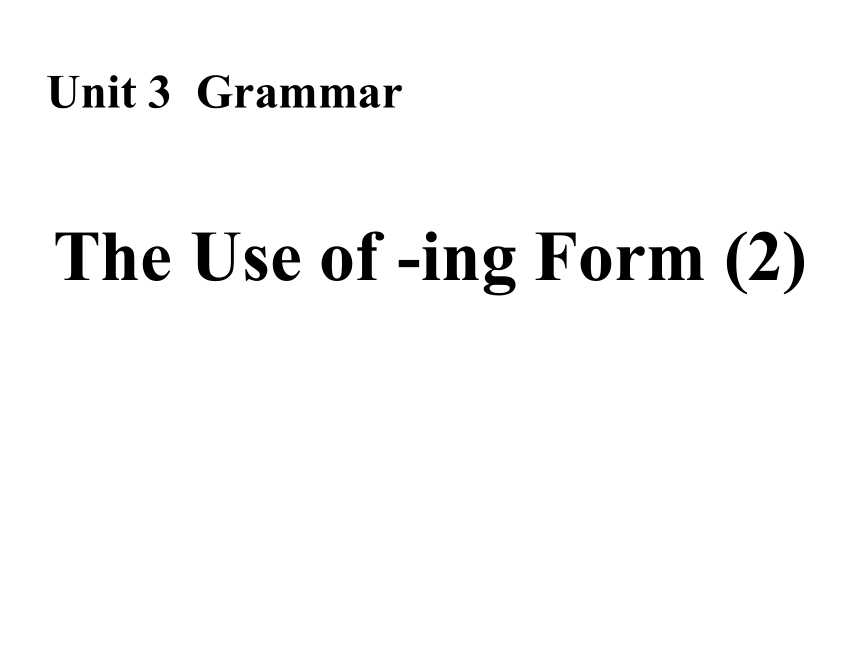 | |
| 格式 | zip | ||
| 文件大小 | 116.3KB | ||
| 资源类型 | 教案 | ||
| 版本资源 | 人教版(新课程标准) | ||
| 科目 | 英语 | ||
| 更新时间 | 2016-10-22 12:31:40 | ||
图片预览

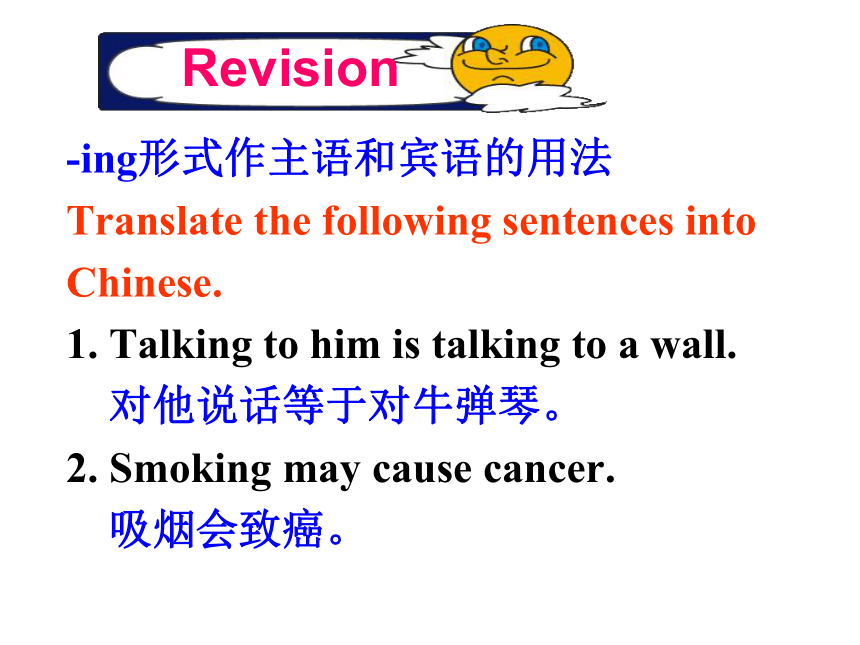
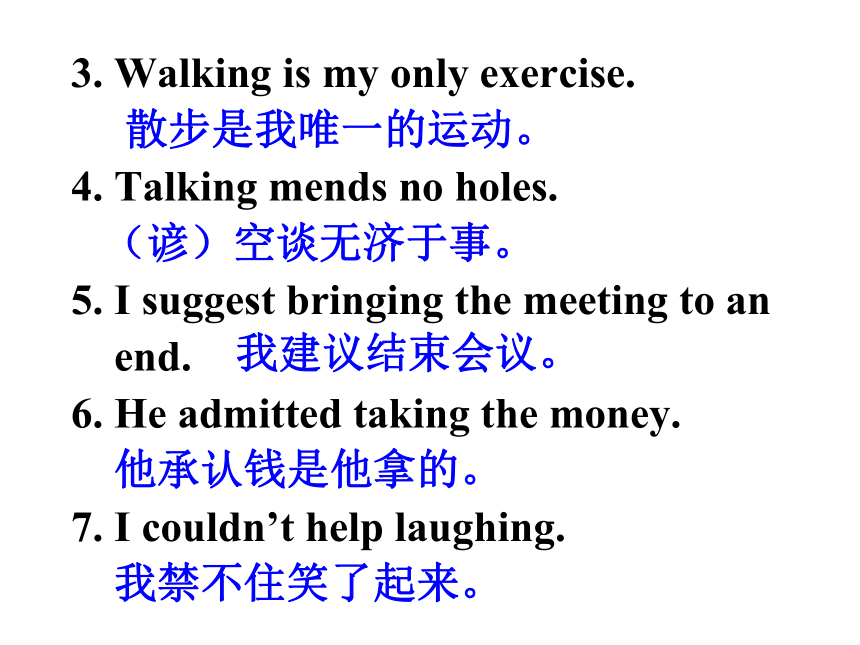
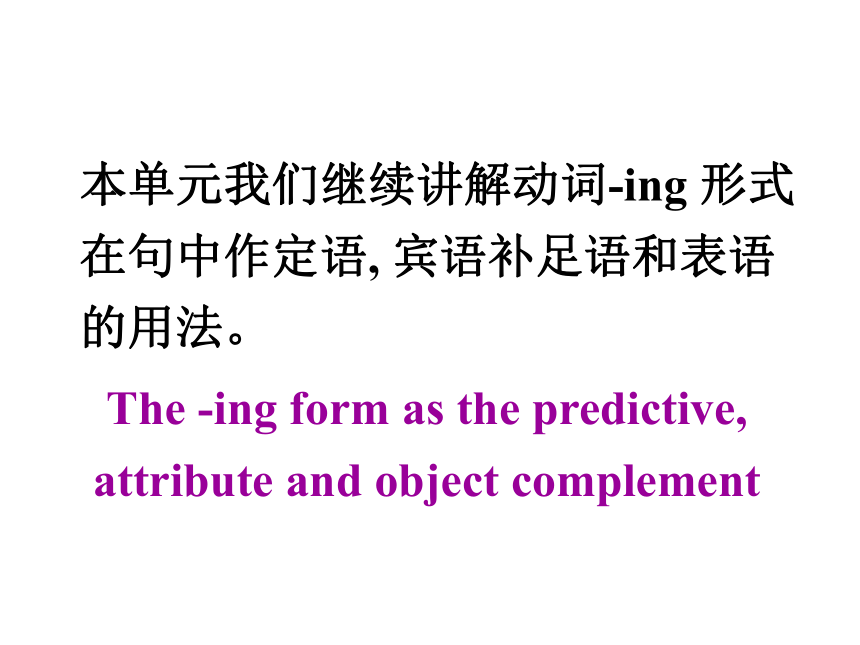
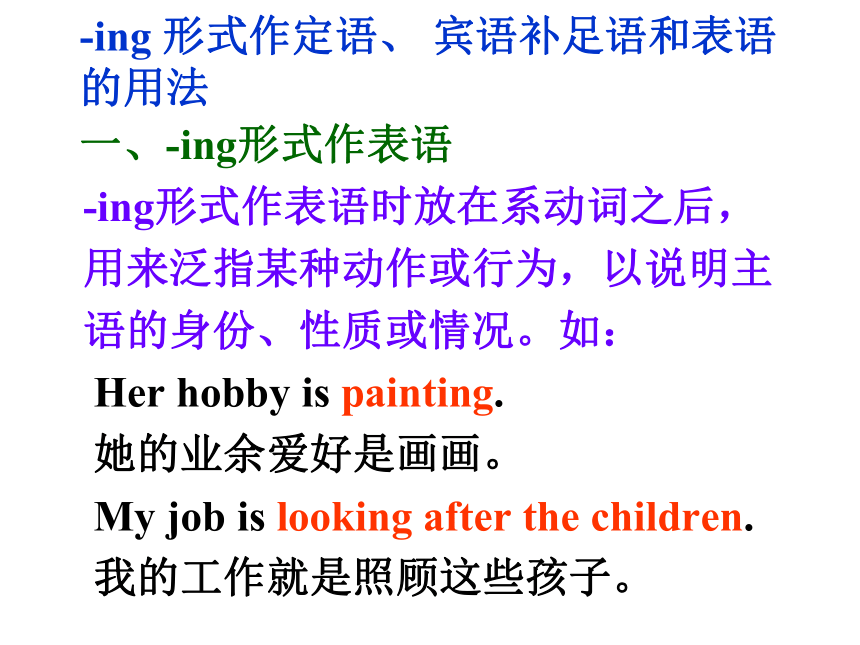
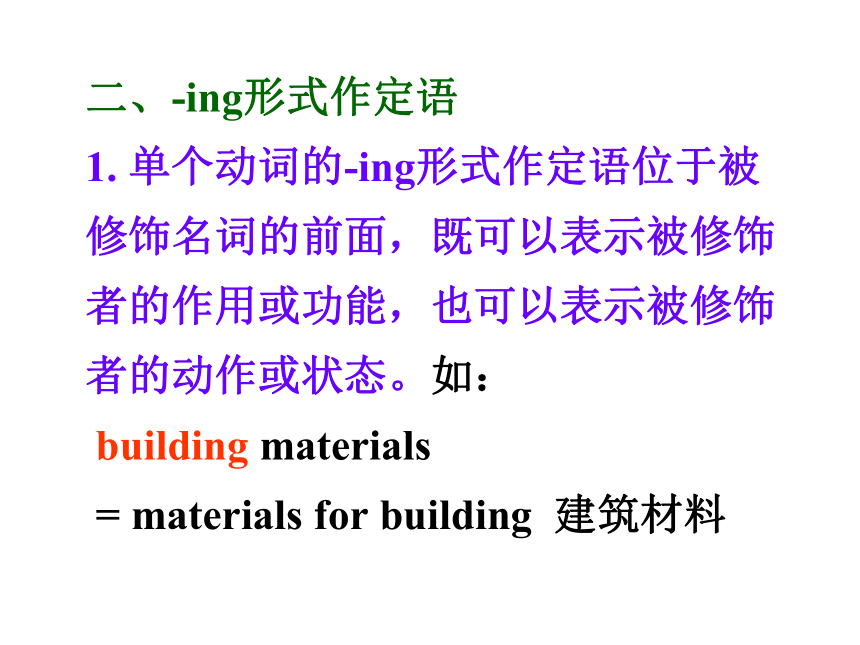
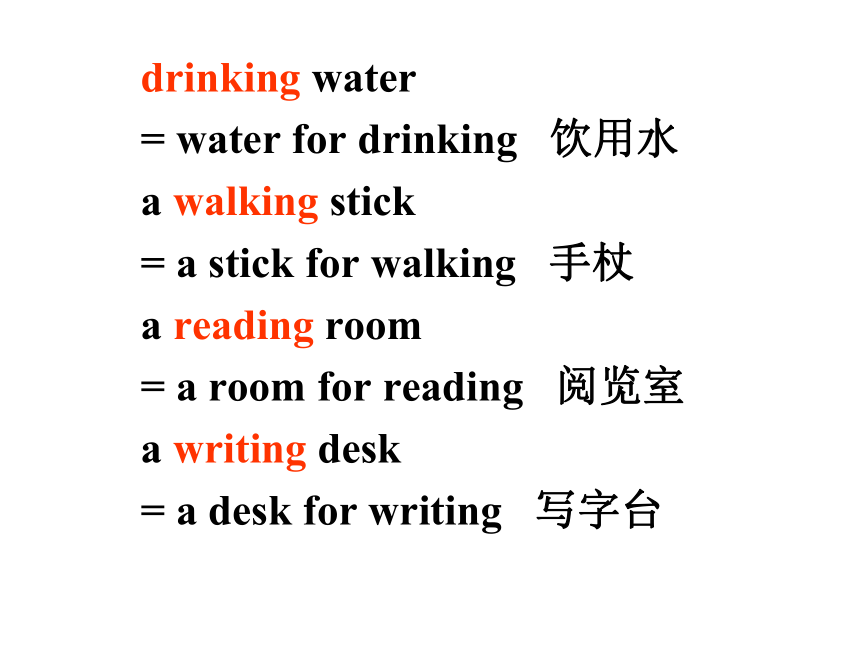


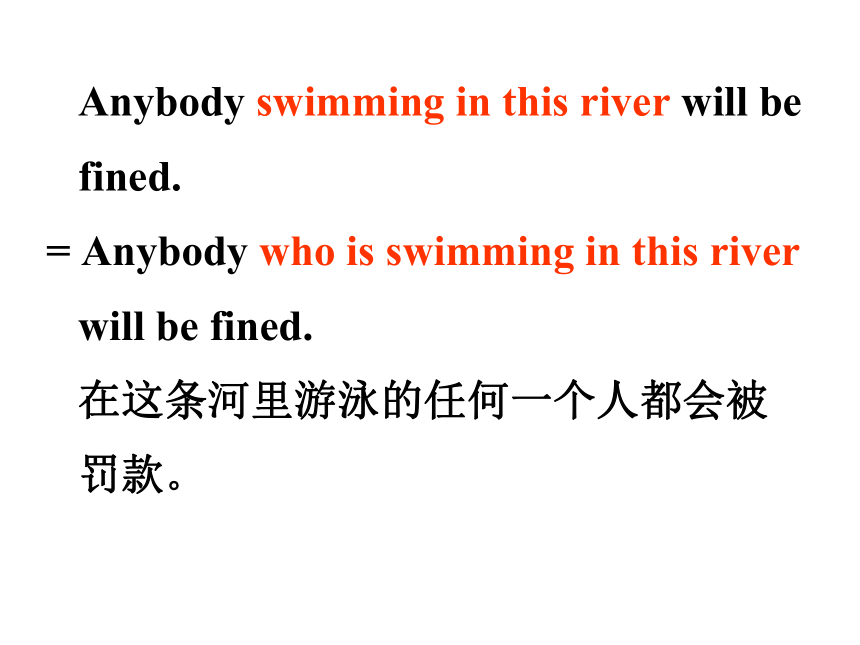
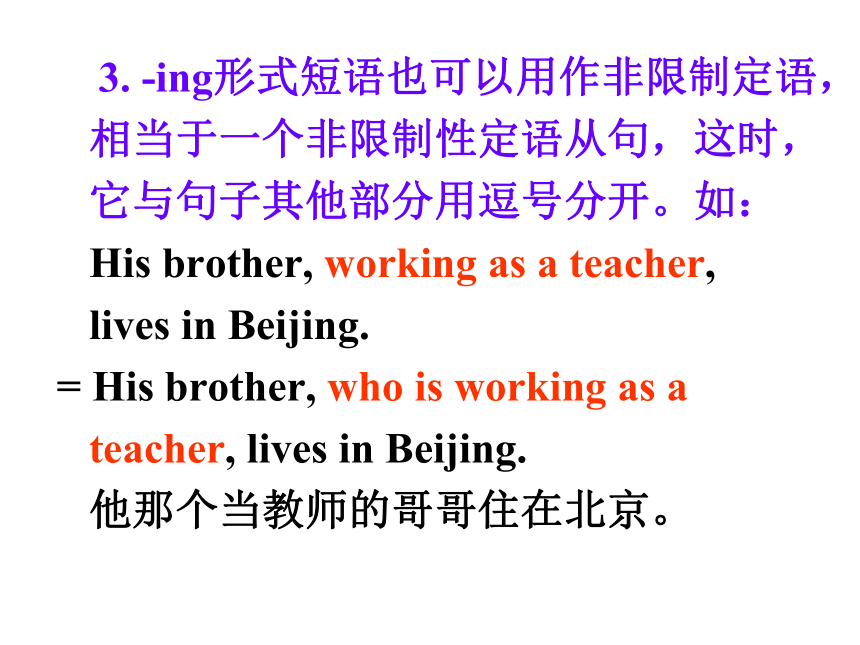
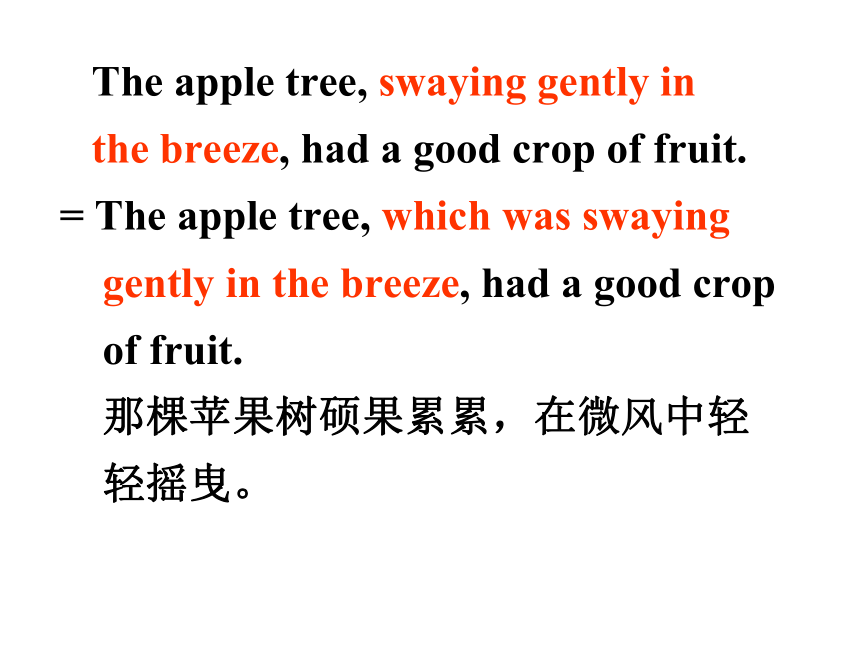
文档简介
课件37张PPT。Unit 3 GrammarThe Use of -ing Form (2)Revision-ing形式作主语和宾语的用法
Translate the following sentences into
Chinese.
1. Talking to him is talking to a wall.
对他说话等于对牛弹琴。
2. Smoking may cause cancer.
吸烟会致癌。3. Walking is my only exercise.
散步是我唯一的运动。
4. Talking mends no holes.
(谚)空谈无济于事。
5. I suggest bringing the meeting to an
end.
6. He admitted taking the money.
他承认钱是他拿的。
7. I couldn’t help laughing.
我禁不住笑了起来。我建议结束会议。本单元我们继续讲解动词-ing 形式
在句中作定语, 宾语补足语和表语
的用法。The -ing form as the predictive, attribute and object complement 一、-ing形式作表语
-ing形式作表语时放在系动词之后,
用来泛指某种动作或行为,以说明主语的身份、性质或情况。如:
Her hobby is painting.
她的业余爱好是画画。
My job is looking after the children.
我的工作就是照顾这些孩子。-ing 形式作定语、 宾语补足语和表语的用法 二、-ing形式作定语
1. 单个动词的-ing形式作定语位于被修饰名词的前面,既可以表示被修饰者的作用或功能,也可以表示被修饰者的动作或状态。如:
building materials
= materials for building 建筑材料drinking water
= water for drinking 饮用水
a walking stick
= a stick for walking 手杖
a reading room
= a room for reading 阅览室
a writing desk
= a desk for writing 写字台 tiring music
= music that is tiring 烦人的音乐
a surprising result
= a result that is surprising
一个惊人的结果
2. -ing形式短语作定语时, 放在所修饰的名词之后, 并且在意思上相当于一个定语从句。如: They lived in a room facing the street.
= They lived in a room that faces the
street.
他们住在一间面朝街的房子。
The man standing there is Peter’s father.
= The man who is standing there is
Peter’s father.
站在那儿的那个人是彼得的父亲。 Anybody swimming in this river will be fined.
= Anybody who is swimming in this river will be fined.
在这条河里游泳的任何一个人都会被罚款。 3. -ing形式短语也可以用作非限制定语,相当于一个非限制性定语从句,这时,它与句子其他部分用逗号分开。如:
His brother, working as a teacher,
lives in Beijing.
= His brother, who is working as a
teacher, lives in Beijing.
他那个当教师的哥哥住在北京。 The apple tree, swaying gently in
the breeze, had a good crop of fruit.
= The apple tree, which was swaying
gently in the breeze, had a good crop
of fruit.
那棵苹果树硕果累累,在微风中轻
轻摇曳。 三、-ing形式作宾语补足语
1. 动词-ing形式作宾语补足语常放在宾语后面,表示一个正在进行的主动性的动作,强调一个过程或一种状态。如:
When we returned to the school, we found a stranger standing at the entrance.
当我们回到学校时, 发现一个陌生人站在大门口。 We found the snake eating the eggs.
我们发现蛇正在吃鸡蛋。
I found a bag lying on the ground.
我发现地板上放着一个包。
The boss kept the workers working the whole night.
那老板让工人整夜地工作。 2. 当主句转换为被动结构时, 原来作宾语补足语的动词-ing形式便转换为主语补足语。如:
They found the result very satisfying.
= The result is found very satisfying.
这个结果很令人满意。 They heard him singing in the next
room.
= He was heard singing in the next room.
有人听到他在隔壁房间唱歌。
We mustn’t keep them waiting.
= They mustn’t be kept waiting.
千万不能让他们等。 3. 能用-ing形式作宾语补足语的几类动词:
(1) 表示感觉和心理状态的动词,常见的有see, hear, feel, smell, find, notice, observe, look at, listen to等。如:
a. We saw a light burning in the window.
b. I felt somebody patting me on the shoulder. c. Can you smell anything burning?
d. As he spoke, he observed everybody
looking at him curiously.
e. Listen to the birds singing.
f. I didn’t notice him waiting.
(2) 表示指使意义的动词,常见的有have, set, keep, get, catch, leave等。a. I won’t have you doing that.
b. This set me thinking.
c. I’m sorry to have kept you waiting.
d. I can’t get the clock going again.
e. You won’t catch me doing that again.4. see, hear, feel, watch等动词之后用-ing形式和动词不定式作宾语补足语的区别:
We passed by the classmates and
saw the teacher making the experiment.
我们走过教室,看见老师在做实验。
(只在走过教室的刹那间,看见老师
正在做实验)(1) 前者表示动作正在进行,后者表示
(或强调)动作从开始到结束的全过程。 We sat an hour and watched the teacher make the experiment.
我们坐了一个小时,看老师做实验。
(一个小时之内一直在看老师做实验)
(2)如果宾语补足语是短暂性动词,动词不定式短语表示一次动作, 而-ing形式
则表示反复动作。如:
We heard the door slam.
We heard the door slamming. (反复动作)(一次动作)1. Do you find it funny to see someone
sliding on a banana skin, bumping
into someone else round a corner, or
falling down a hole in the road? Point out the usage of the –ing form.sliding, bumping, falling 作宾语补足语 2. He became famous for using a
particular form of acting, including
mime and farce. 3. Their job is “panning for gold”.using 作介词for的宾语;
including作状语panning 作表语4. But he was lived by all who watched
the films for his determination in
overcoming difficulties and being kind
even when people were unkind to him. overcoming作介词宾语5. Finally he tries cutting and eating the
bottom of the shoe.cutting, eating 作宾语6. That was the problem facing Charlie
Chaplin in one of his most famous films.facing 作定语 using 作介词宾语7. He loved it by using nonverbal humor. Don’t leave the water _______ while
you brush your teeth.
A. run B. running
C. being run D. to run 单选2. John’s bad habit is _____ without
thorough understanding.
A. read B. being read
C. to be read D. reading 3. Tell Mary that there’s someone ____
for her at the door.
A. waiting B. waited
C. waits D. to wait4. The _______ waiter came up to us
and said, “You are welcome.”
A. smiling B. smiled
C. smile D. to smile 5. A phone call sent him _______ to the
hospital.
A. hurry B. hurrying
C. to hurry D. hurried6. Do you know the boy _______ under
the big tree?
A. lay B. lain
C. laying D. lying 7. There are lots of places of interest
_______ in our city.
? A. needs repairing
B. needing repaired
? C. needed repairing
D. needing to be repaired 8. The drunken husband knocked
against the table and sent the bowls
_______ in all directions before he
was sent _______ by his wife.
? A. flying; to sleep
B. flying; sleeping
C. to fly; to sleeping
D. to fly; to sleep 9. When we got back from the cinema,
we found the lamp _______ but the
door _______.
A. being on; shut
B. burning; shutting
C. burning; shut
D. on; shutting10. As is known to us all, traveling is
_____, but we often feel _____ when
we are back from travels.
? A. interesting; tired
B. interested; tiring
C. interesting; tiring
D. interested; tired 11. The woman found it no good _____
her daughter too much money.
A. giving B. being given
C. given D. gave12. As the stone was too heavy to move,
I left it _____on the ground.
? A. laying B. lay
C. lying D. lain1. I am looking forward to visit Charlie
Chaplin Museum in Switzerland next
week. visitingPlease read the sentences carefully,
trying to pick out the errors and
then correct them. 2. Many people still enjoy seeing Charlie Chaplin’s silent films.
3. That cartoon picture shows Charlie Chaplin watch himself watching in a movie.
4. Charlie’s nonverbal humor often makes people bursting with laughter. √watchingburst 5. We are all fond of Charlie’s early films, which we think are more interested.
6. I missed to see the beginning of the film City Lights the other day.
7. I wouldn’t mind to see The Gold Rush again with you tonight. interestingseeingseeingThank you.
Translate the following sentences into
Chinese.
1. Talking to him is talking to a wall.
对他说话等于对牛弹琴。
2. Smoking may cause cancer.
吸烟会致癌。3. Walking is my only exercise.
散步是我唯一的运动。
4. Talking mends no holes.
(谚)空谈无济于事。
5. I suggest bringing the meeting to an
end.
6. He admitted taking the money.
他承认钱是他拿的。
7. I couldn’t help laughing.
我禁不住笑了起来。我建议结束会议。本单元我们继续讲解动词-ing 形式
在句中作定语, 宾语补足语和表语
的用法。The -ing form as the predictive, attribute and object complement 一、-ing形式作表语
-ing形式作表语时放在系动词之后,
用来泛指某种动作或行为,以说明主语的身份、性质或情况。如:
Her hobby is painting.
她的业余爱好是画画。
My job is looking after the children.
我的工作就是照顾这些孩子。-ing 形式作定语、 宾语补足语和表语的用法 二、-ing形式作定语
1. 单个动词的-ing形式作定语位于被修饰名词的前面,既可以表示被修饰者的作用或功能,也可以表示被修饰者的动作或状态。如:
building materials
= materials for building 建筑材料drinking water
= water for drinking 饮用水
a walking stick
= a stick for walking 手杖
a reading room
= a room for reading 阅览室
a writing desk
= a desk for writing 写字台 tiring music
= music that is tiring 烦人的音乐
a surprising result
= a result that is surprising
一个惊人的结果
2. -ing形式短语作定语时, 放在所修饰的名词之后, 并且在意思上相当于一个定语从句。如: They lived in a room facing the street.
= They lived in a room that faces the
street.
他们住在一间面朝街的房子。
The man standing there is Peter’s father.
= The man who is standing there is
Peter’s father.
站在那儿的那个人是彼得的父亲。 Anybody swimming in this river will be fined.
= Anybody who is swimming in this river will be fined.
在这条河里游泳的任何一个人都会被罚款。 3. -ing形式短语也可以用作非限制定语,相当于一个非限制性定语从句,这时,它与句子其他部分用逗号分开。如:
His brother, working as a teacher,
lives in Beijing.
= His brother, who is working as a
teacher, lives in Beijing.
他那个当教师的哥哥住在北京。 The apple tree, swaying gently in
the breeze, had a good crop of fruit.
= The apple tree, which was swaying
gently in the breeze, had a good crop
of fruit.
那棵苹果树硕果累累,在微风中轻
轻摇曳。 三、-ing形式作宾语补足语
1. 动词-ing形式作宾语补足语常放在宾语后面,表示一个正在进行的主动性的动作,强调一个过程或一种状态。如:
When we returned to the school, we found a stranger standing at the entrance.
当我们回到学校时, 发现一个陌生人站在大门口。 We found the snake eating the eggs.
我们发现蛇正在吃鸡蛋。
I found a bag lying on the ground.
我发现地板上放着一个包。
The boss kept the workers working the whole night.
那老板让工人整夜地工作。 2. 当主句转换为被动结构时, 原来作宾语补足语的动词-ing形式便转换为主语补足语。如:
They found the result very satisfying.
= The result is found very satisfying.
这个结果很令人满意。 They heard him singing in the next
room.
= He was heard singing in the next room.
有人听到他在隔壁房间唱歌。
We mustn’t keep them waiting.
= They mustn’t be kept waiting.
千万不能让他们等。 3. 能用-ing形式作宾语补足语的几类动词:
(1) 表示感觉和心理状态的动词,常见的有see, hear, feel, smell, find, notice, observe, look at, listen to等。如:
a. We saw a light burning in the window.
b. I felt somebody patting me on the shoulder. c. Can you smell anything burning?
d. As he spoke, he observed everybody
looking at him curiously.
e. Listen to the birds singing.
f. I didn’t notice him waiting.
(2) 表示指使意义的动词,常见的有have, set, keep, get, catch, leave等。a. I won’t have you doing that.
b. This set me thinking.
c. I’m sorry to have kept you waiting.
d. I can’t get the clock going again.
e. You won’t catch me doing that again.4. see, hear, feel, watch等动词之后用-ing形式和动词不定式作宾语补足语的区别:
We passed by the classmates and
saw the teacher making the experiment.
我们走过教室,看见老师在做实验。
(只在走过教室的刹那间,看见老师
正在做实验)(1) 前者表示动作正在进行,后者表示
(或强调)动作从开始到结束的全过程。 We sat an hour and watched the teacher make the experiment.
我们坐了一个小时,看老师做实验。
(一个小时之内一直在看老师做实验)
(2)如果宾语补足语是短暂性动词,动词不定式短语表示一次动作, 而-ing形式
则表示反复动作。如:
We heard the door slam.
We heard the door slamming. (反复动作)(一次动作)1. Do you find it funny to see someone
sliding on a banana skin, bumping
into someone else round a corner, or
falling down a hole in the road? Point out the usage of the –ing form.sliding, bumping, falling 作宾语补足语 2. He became famous for using a
particular form of acting, including
mime and farce. 3. Their job is “panning for gold”.using 作介词for的宾语;
including作状语panning 作表语4. But he was lived by all who watched
the films for his determination in
overcoming difficulties and being kind
even when people were unkind to him. overcoming作介词宾语5. Finally he tries cutting and eating the
bottom of the shoe.cutting, eating 作宾语6. That was the problem facing Charlie
Chaplin in one of his most famous films.facing 作定语 using 作介词宾语7. He loved it by using nonverbal humor. Don’t leave the water _______ while
you brush your teeth.
A. run B. running
C. being run D. to run 单选2. John’s bad habit is _____ without
thorough understanding.
A. read B. being read
C. to be read D. reading 3. Tell Mary that there’s someone ____
for her at the door.
A. waiting B. waited
C. waits D. to wait4. The _______ waiter came up to us
and said, “You are welcome.”
A. smiling B. smiled
C. smile D. to smile 5. A phone call sent him _______ to the
hospital.
A. hurry B. hurrying
C. to hurry D. hurried6. Do you know the boy _______ under
the big tree?
A. lay B. lain
C. laying D. lying 7. There are lots of places of interest
_______ in our city.
? A. needs repairing
B. needing repaired
? C. needed repairing
D. needing to be repaired 8. The drunken husband knocked
against the table and sent the bowls
_______ in all directions before he
was sent _______ by his wife.
? A. flying; to sleep
B. flying; sleeping
C. to fly; to sleeping
D. to fly; to sleep 9. When we got back from the cinema,
we found the lamp _______ but the
door _______.
A. being on; shut
B. burning; shutting
C. burning; shut
D. on; shutting10. As is known to us all, traveling is
_____, but we often feel _____ when
we are back from travels.
? A. interesting; tired
B. interested; tiring
C. interesting; tiring
D. interested; tired 11. The woman found it no good _____
her daughter too much money.
A. giving B. being given
C. given D. gave12. As the stone was too heavy to move,
I left it _____on the ground.
? A. laying B. lay
C. lying D. lain1. I am looking forward to visit Charlie
Chaplin Museum in Switzerland next
week. visitingPlease read the sentences carefully,
trying to pick out the errors and
then correct them. 2. Many people still enjoy seeing Charlie Chaplin’s silent films.
3. That cartoon picture shows Charlie Chaplin watch himself watching in a movie.
4. Charlie’s nonverbal humor often makes people bursting with laughter. √watchingburst 5. We are all fond of Charlie’s early films, which we think are more interested.
6. I missed to see the beginning of the film City Lights the other day.
7. I wouldn’t mind to see The Gold Rush again with you tonight. interestingseeingseeingThank you.
同课章节目录
